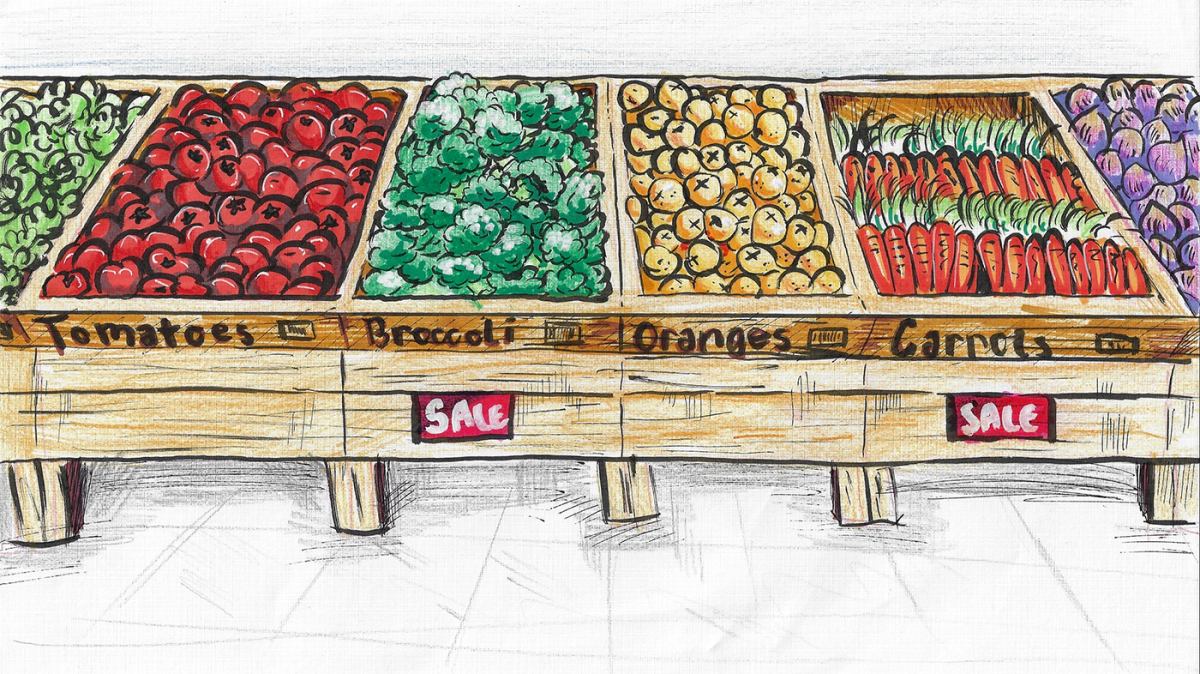A student’s guide to saving big and mastering the art of food shopping

Illustration by Sie Douglas-Fish.
Grocery shopping is a constant in adult life and can be an overwhelming task if you’ve just moved away from home. Even if you’ve been flying solo for years, inflation is making us all rethink the way we spend our money, and food is no exception.
These five tips for saving money on groceries will make you feel like a secret insider and might even change the way you shop.
Unit price is your new best friend
You might have heard of unit price before, probably in an elementary school math lesson or while shopping in bulk. It refers to how much you’re paying for a precise amount of an item, such as 100 g or mL.
Unit price can play a huge role in upping your grocery savings plan, and, thankfully, you don’t need to pull out a calculator every time you head to the store. Some grocery stores include unit price on their price tags for food. Thrifty Foods has unit price on nearly every tag, Walmart only has it on some, and Save-On-Foods doesn’t at all. Check unit price to compare items that you might think are the same.
For example, right now at Save-On-Foods, most varieties of Kraft Dinner are $2.69 per box. If you look closely, though, you’ll notice that they all weigh different amounts. That means you’d be paying $1.35 per 100 g for Extra Creamy, but $1.79 for the same amount of Simply KD.
Choose your store wisely
We’ve all heard that time is money, and no one knows that better than an overworked university student. Streamlining your grocery shopping plan can save you loads of time.
First, choose a store that makes sense for you. If you’re big on points systems, Save-On-Foods might be your best bet. If you care more about selection and unique items, opt for Thrifty Foods. If you’re like me and you’re interested in the cheapest prices, then Walmart is the place to go.
Once you’ve made this decision, stick to it. Knowing the layout and flow of your chosen store will save you tons of time, and feeling comfortable in the store will help you find the best deals. Lastly, I like to shop early in the morning to avoid crowds. It’s always quicker and easier when you’re not dodging other carts.
Study the sales tags
There are many ins and outs to sales that often go overlooked. For starters, it’s important to read both the sale tag and the normal tags around it. An on-sale brand name item might still be more expensive than its store-brand equivalent.
Another detail to watch out for on sale tags are rules about quantity. At some stores, when a chocolate bar’s tag says “2 for $6,” that means that if you buy one bar, it will still only cost $3. At others, however, any similar tag requires that you purchase the quantity given. It will have an individual price below the “2 for $6” tag, so buying only one might cost $3.29, for example.
Many stores have dedicated racks where you can find items that are close to expiring, often in bakery and deli sections. This can be an amazing cost-saving tool, especially if you like to meal prep. Always have a plan for what you’ll do with the ingredient or food, though. It may seem obvious, but remember that you’re still losing money if you let an on-sale soon-to-expire food go to waste.
Make a list but keep it loose
A simple tool for saving money on groceries is to spend a bit of time before your shopping trip making a list. This can not only cut down on time inside the store, but it can help to prevent impulse buying.
Write the list according to your meal plan for the week, but don’t feel the need to over-prepare by selecting specific brands, types, or varieties. If you’re willing to be flexible, you’ll save a lot of money by choosing on-sale items that match your list. For example, I like to buy granola bars each week, and I decide on which variety once I get to the store. You can pre-plan by studying flyers, but I find it faster to choose once I’m there.
Buying more will save you more
One rule is that larger quantity items nearly always have a lower unit price. If you’re on good terms with your roommates, it’s always good practice to coordinate buying staples like flour and rice. This will save you tons of money because buying the smallest bottle of olive oil over and over is much more expensive than buying a big one to share.
If you have enough storage space, then buying bigger boxes of non-perishables, especially when on sale, is also a good idea. Cans can last for years, so stock up on beans and tomatoes when they’re the cheapest.
Hopefully these tips will make you feel a bit more savvy and less overwhelmed when it comes to the grocery store. Try not to brag too much about your new-found hobby to your friends, though, because they might make you tag along on their own trips.








